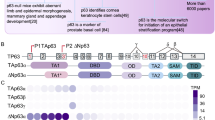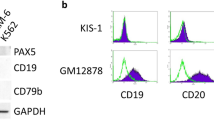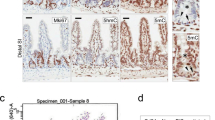Abstract
Dmp1 is a Myb-like transcription factor that transmits oncogenic Ras-Raf signaling to the Arf-p53 pathway and induces cell cycle arrest. Immunohistochemical staining was performed to identify the pattern of Dmp1 expression in normal murine tissues compared with the proliferation marker, Ki67. In thymus, the nuclei of mature T lymphocytes in the medulla were strongly positive for Dmp1, whereas Ki67 was detected only in the cortex. In intestine, Dmp1 was detected in the nuclei of superficial layers of the villi, whereas Ki67-positive cells were confined to the lower one-third of the crypt. Double staining for Dmp1 and Ki67 revealed that these two proteins were expressed in mutually exclusive fashion in nearly all the tissues examined. Subsets of E2Fs were specifically bound to the Dmp1 promoter upon mitogenic signaling and E2Fs 1-4 inhibited the Dmp1 promoter in a reporter assay. The Dmp1 promoter was repressed when the cells entered the S to G2/M phase of the cell cycle when both Dmp1 and Arf expressions were downregulated. The Dmp1 mRNA was not downregulated by serum in E2F-DB(+) cells, suggesting that the Dmp1 promoter repression is E2F-dependent. This explains why the Dmp1 and Ki67-positive cells are stained in mutually exclusive fashion in normal tissues.
This is a preview of subscription content, access via your institution
Access options
Subscribe to this journal
Receive 50 print issues and online access
$259.00 per year
only $5.18 per issue
Buy this article
- Purchase on Springer Link
- Instant access to full article PDF
Prices may be subject to local taxes which are calculated during checkout






Similar content being viewed by others
References
Aslanian A, Iaquinta PJ, Verona R, Lees JA . (2004). Genes Dev 18: 1413–1422.
Barrett K, Willingham JM, Garvin AJ, Willingham MC . (2001). J Histochem Cytochem 49: 821–832.
Bentley HA, Belloni DR, Tsongalis GJ . (2005). Clin Biochem 38: 183–186.
Bertwistle D, Zindy F, Sherr CJ, Roussel MF . (2004). Hybrid Hybridomics 23: 293–300.
Campanero M, Armstrong M, Flemington E . (1999). Mol Cell Biol 19: 8442–8450.
Catchpole S, Tavner F, Cam LE, Sardet C, Watson RJ . (2002). J Biol Chem 277: 39015–39024.
Chadee DN, Hendzel MJ, Tylipski CP, Allis CD, Bazett-Jones DP, Wright JA et al. (1999). J Biol Chem 274: 24914–24920.
Crowe DL, Nguyen DC, Tsang KJ, Kyo S . (2001). Nucleic Acid Res 29: 2789–2794.
DeGregori J, Kowalik T, Nevins JR . (1995). Mol Cell Biol 15: 4215–4224.
DeGregori J . (2002). Biochem Biophys Acta 1602: 131–150.
el-Deiry WS, Tokino T, Waldman T, Oliner JD, Velculesu VE, Burrell M et al. (1995). Cancer Res 55: 2910–2919.
Hirai H, Sherr CJ . (1996). Mol Cell Biol 16: 6457–6467.
Inoue K, Roussel MF, Sherr CJ . (1999). Proc Natl Acad Sci USA 96: 3993–3998.
Inoue K, Sherr CJ . (1998). Mol Cell Biol 18: 1590–1600.
Inoue K, Sherr CJ, Shapiro LH . (1998). J Biol Chem 273: 29188–29194.
Inoue K, Sugiyama H, Ogawa H, Yamagami T, Azuma T, Oka Y et al. (1994). Blood 84: 2672–2680.
Inoue K, Wen R, Rehg JE, Adachi M, Cleveland JL, Roussel MF et al. (2000). Genes Dev 14: 1797–1809.
Inoue K, Zindy F, Randle DH, Rehg JE, Sherr CJ . (2001). Genes Dev 15: 2934–2939.
Joaquin M, Watson RJ . (2003). Cell Mol Life Sci 60: 2389–2401.
Johnson DG, Schwartz JK, Cress WD, Nevins JR . (1993). Nature 365: 349–352.
Kamijo T, Bodner S, van de Kamp E, Randle DH, Sherr CJ . (1999). Cancer Res 59: 2217–2222.
Kamijo T, Zindy F, Roussel MF, Quelle DE, Downing JR, Ashmun RA et al. (1997). Cell 91: 649–659.
Kindblom LG, Ahlden M, Meis-Kindblom JM, Stenman G . (1995). Virchows Arch 427: 19–26.
Leone G, Nuckolls F, Ishida S, Adams M, Sears R, Jakoi L et al. (2000). Mol Cell Biol 20: 3626–3632.
Lindeman GJ, Gaubatz S, Livingston DM, Ginsberg D . (1997). Proc Natl Acad Sci USA 94: 5095–5100.
Lopez F, Belloc F, Lacombe F, Dumain P, Reiffers J, Bernard P et al. (1991). Cytometry 12: 42–49.
Lowe S, Sherr CJ . (2003). Curr Opin Genet Dev 13: 77–83.
Lu Z, Luo RZ, Peng H, Huang M, Nishimoto A, Hunt KK et al. (2006). Oncogene 25: 230–239.
Oh I-H, Reddy EP . (1999). Oncogene 18: 3017–3033.
Quon K, Berns A . (2001). Genes Dev 15: 2917–2921.
Rowland B, Denissov SG, Douma S, Stunnenburg HG, Bernards R, Peeper DS . (2002). Cancer Cell 2: 55–65.
Ruas M, Peters G . (1998). Biochem Biophys Acta Rev Cancer 1378: F115–F177.
Sala A, Watson R . (1999). J Cell Physiol 179: 245–250.
Sheiness D, Gardinier M . (1984). Mol Cell Biol 4: 1206–1212.
Sherr CJ . (2001). Nat Rev Mol Cell Biol 2: 731–737.
Sherr CJ, Roberts JM . (1999). Genes Dev 13: 1501–1512.
Sreeramaneni R, Chaudhry A, McMahon M, Sherr CJ, Inoue K . (2005). Mol Cell Biol 25: 220–232.
Trimarch JM, Lees JA . (2002). Nat Rev Mol Cell Biol 3: 11–20.
Wu L, Timmers C, Maiti B, Saavedra HI, Sang L, Chong GT et al. (2001). Nature 414: 457–462.
Zindy F, Quelle DE, Roussel MF, Sherr CJ . (1997). Oncogene 15: 203–211.
Zindy F, Williams RT, Baudino TA, Rehg JE, Skapek SX, Cleveland JL et al. (2003). Proc Natl Acad Sci USA 100: 15930–15935.
Acknowledgements
We are grateful to Dr Tim Kute for helpful discussions. We thank Asif Chaudhry and Oktay Kaplan for technical assistance, Drs Charles Sherr, Martine Roussel, Joseph Nevins, Geoffrey Lindeman, Rene Bernards, and Michael Ostrowski for plasmid DNAs. We also thank Dr Michael Robbins for editing and critical reading of the manuscript. This work was supported by National Institute of Health Grant 5R01CA106312-02 (K Inoue) and WFUCCC push grant CA12197-31 (K Inoue). Supplementary material 1 is available at Oncogene's website.
Author information
Authors and Affiliations
Corresponding author
Additional information
Supplementary Information accompanies the paper on the Oncogene website (http://www.nature.com/onc)
Supplementary information
Rights and permissions
About this article
Cite this article
Mallakin, A., Taneja, P., Matise, L. et al. Expression of Dmp1 in specific differentiated, nonproliferating cells and its regulation by E2Fs. Oncogene 25, 7703–7713 (2006). https://doi.org/10.1038/sj.onc.1209750
Received:
Revised:
Accepted:
Published:
Issue Date:
DOI: https://doi.org/10.1038/sj.onc.1209750
Keywords
This article is cited by
-
Long Non-coding RNA LINC01420 Contributes to Pancreatic Cancer Progression Through Targeting KRAS Proto-oncogene
Digestive Diseases and Sciences (2020)
-
Prognostic value of the hDMP1-ARF-Hdm2-p53 pathway in breast cancer
Oncogene (2013)
-
Repression of Dmp1 and Arf transcription by anthracyclins: critical roles of the NF-κB subunit p65
Oncogene (2007)
-
Dmp1 and tumor suppression
Oncogene (2007)



